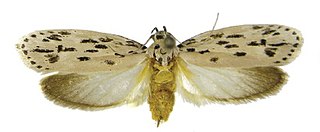
The tawny speckled pug is a moth of the family Geometridae.

The heart and dart is a moth of the family Noctuidae. The species was first described by Carl Linnaeus in his 1758 10th edition of Systema Naturae. A familiar moth to many, it is considered one of the most common of the European region. It occurs throughout the Palearctic realm from Ireland to Japan.

The setaceous Hebrew character is a moth of the family Noctuidae. The species was first described by Carl Linnaeus in his 1758 10th edition of Systema Naturae. It is found in the Palearctic realm. It is a common species throughout Europe and North Asia and Central Asia, South Asia, China, Japan and Korea. It is also found in North America, from coast to coast across Canada and the northern United States to western Alaska. It occurs in the Rocky Mountains from Montana to southern Arizona and New Mexico. In the east, it ranges from Maine to North Carolina. It has recently been recorded in Tennessee.

Asterocampa clyton, the tawny emperor, is a species of brush-footed butterfly. It is native to North America, especially the eastern half from Canada to northern Mexico. The tawny emperor should not be mistaken for a very similar Asterocampa butterfly, the hackberry emperor, which can be distinguished by the white spots near the tip of its forewing and the black eyespot lower along the edge of the forewing.

Palpita vitrealis, common name jasmine moth or white pearl, is a species of moth of the family Crambidae.

Nola aerugula, the scarce black arches, is a moth of the family Nolidae found in Asia and Europe. The species was first described by the German entomologist, Jacob Hübner in 1793.
Scotura quadripuncta is a moth of the family Notodontidae. It is found in Amazonian Brazil and southern Venezuela.
Pyramidobela agyrtodes is a moth in the family Oecophoridae. It is found from in southern North America from extreme western Texas to southern Chihuahua and Nuevo León.
Ethmia scylla is a moth in the family Depressariidae. It is in California, United States.
Ethmia orestella is a moth in the family Depressariidae. It is found in Colorado, United States.
Ethmia epileuca is a moth in the family Depressariidae. It is found in the United States in southern California and Tucson, Arizona.

Ethmia arctostaphylella is a moth in the family Depressariidae. It is found in the United States and Mexico from southern Oregon and northern California, southward to the Sierra San Pedro Martir in Baja California and eastward in southern Nevada and Arizona. The range possibly extends northward in Oregon and into Utah following the distribution of its host plants.
Ethmia burnsella is a moth in the family Depressariidae. It is found in the United States in northern Texas.
Ethmia kirbyi is a moth in the family Depressariidae. It is found in Haiti and Puerto Rico.
Ethmia proximella is a moth in the family Depressariidae. It is found in Mexico.
Ethmia gelidella is a moth in the family Depressariidae. It is found in Jamaica.

Ethmia duckworthi is a moth in the family Depressariidae. It is found in Panama and Costa Rica.

Ethmia sandra is a moth in the family Depressariidae. It is found from Mexico to El Salvador and Costa Rica.
Ethmia omega is a moth in the family Depressariidae. It is found in Brazil.

Dunama jessiebarronae is a moth in the family Notodontidae. It is found in Costa Rica, where it is only known from the eastern slopes of the Cordillera Volcanica de Guanacaste, Cordillera Volcanica Central, Cordillera de Talamanca, llanuras de Sarapiqui, and the lowlands of the Caribbean, at elevations ranging from 50 to 1,115 meters.









